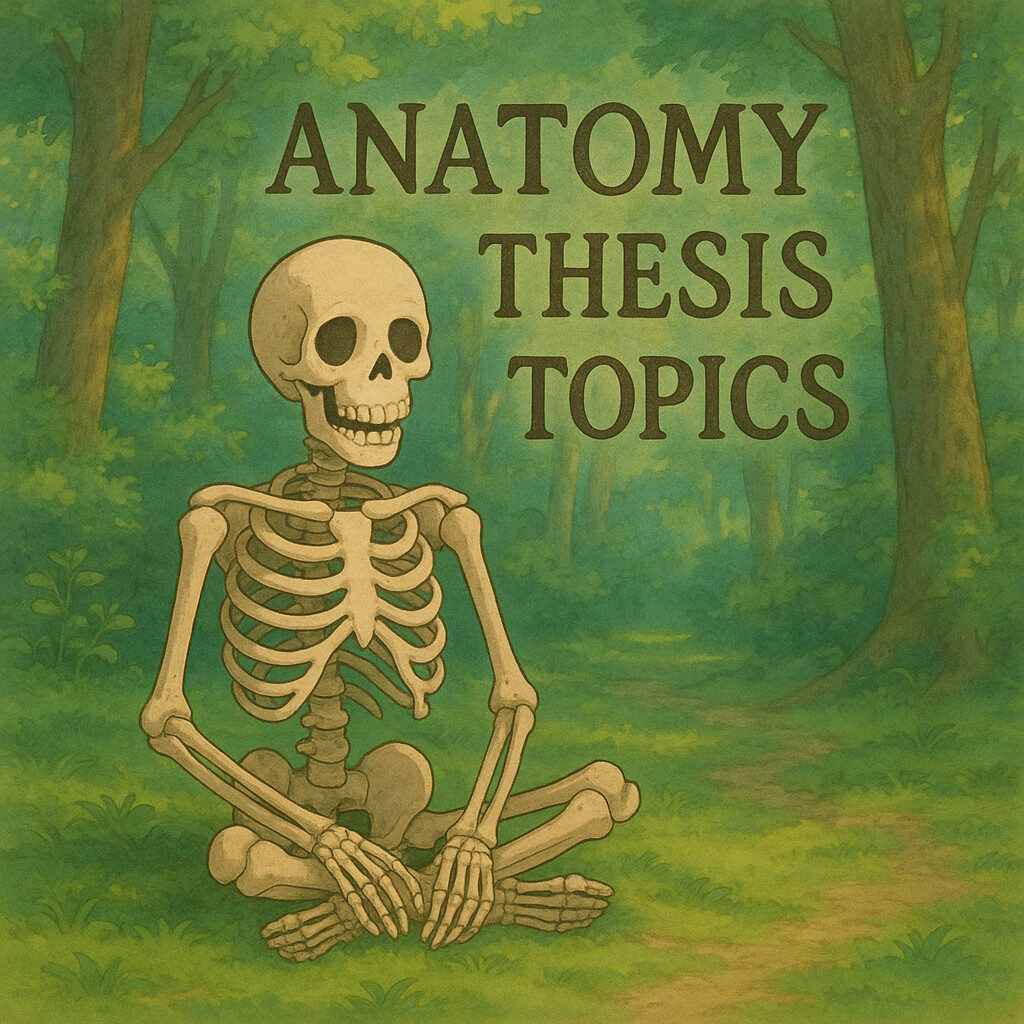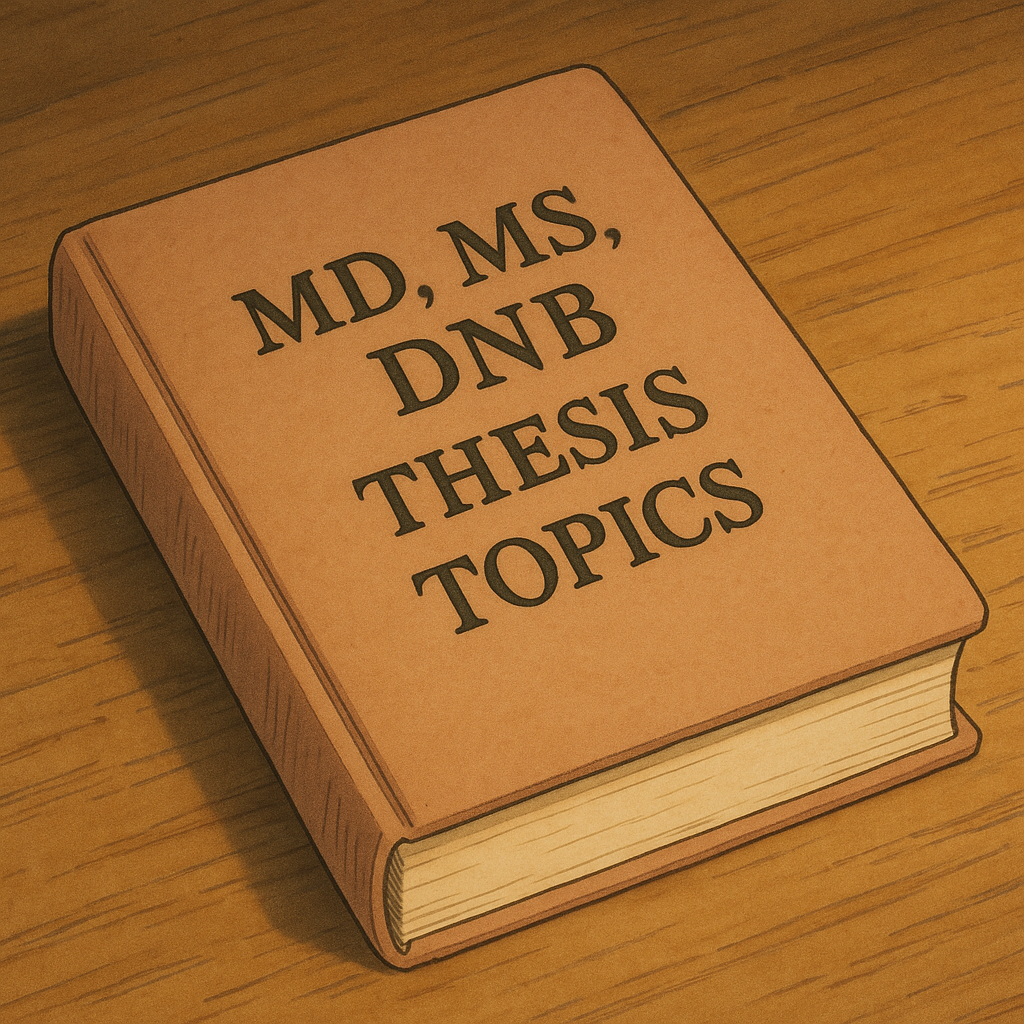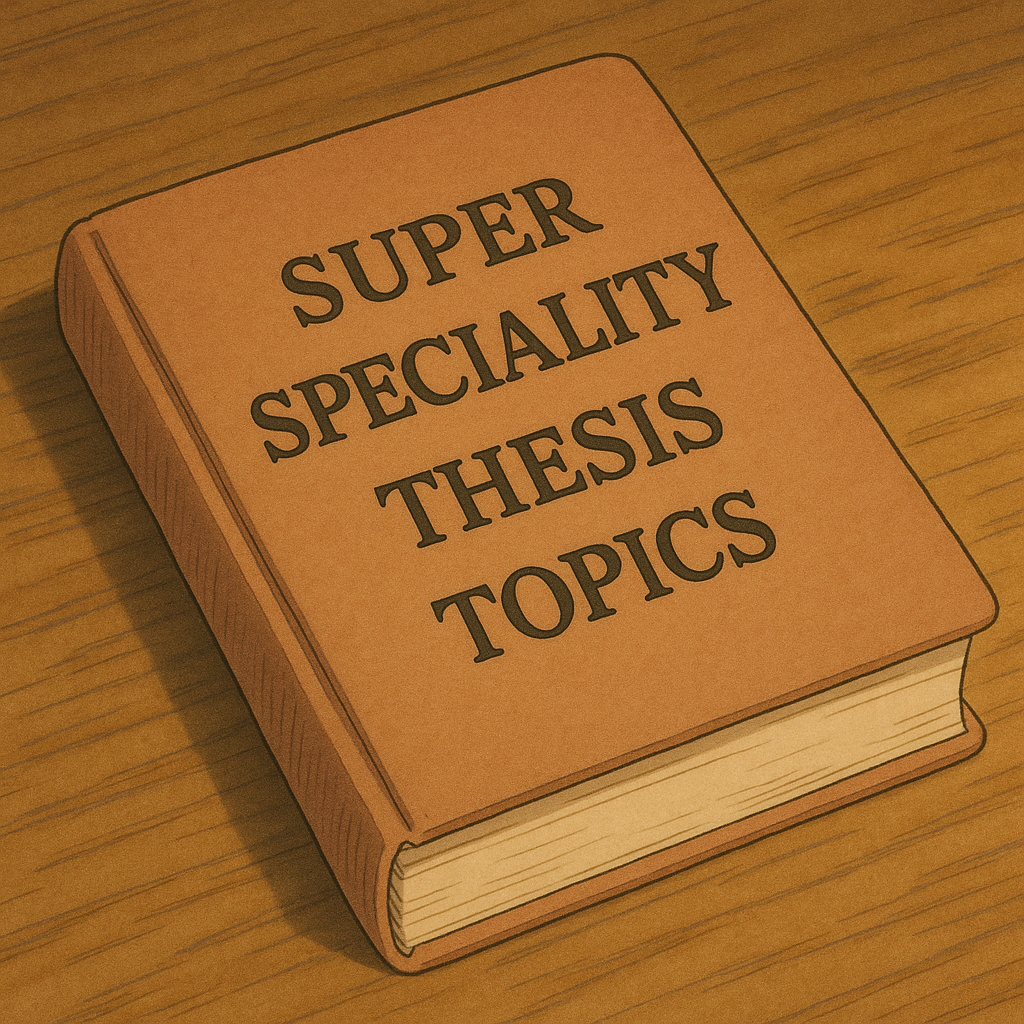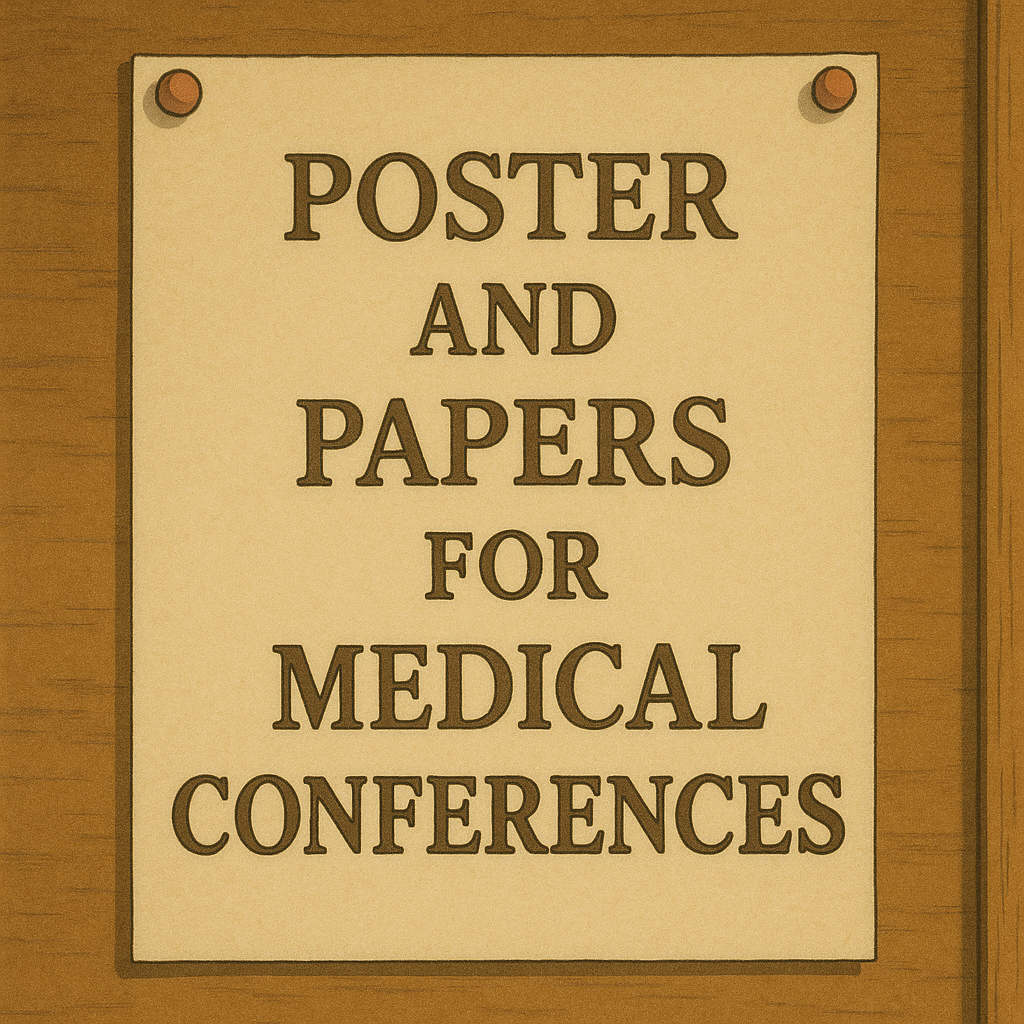ANATOMY THESIS TOPICS

ANATOMY THESIS TOPICS
Choosing the right anatomy thesis topics is crucial for every medical postgraduate. High-quality anatomy thesis topics not only build strong academic foundations but also open pathways to research publications. Students can explore various sections such as gross anatomy, microscopic anatomy (histology), developmental anatomy (embryology), neuroanatomy, and clinical anatomy. Each of these categories offers rich ground for impactful research. Selecting impactful anatomy thesis topics enhances learning, contributes to science, and increases the chances of getting published in reputed medical journals. Since a published thesis is often a mandatory requirement for academic appointments and promotions in medical colleges, careful topic selection is not just beneficial—it’s essential.
1. Osteology (Bone Morphology and Morphometry)
“Three-dimensional CT morphometric analysis of clavicular curvature and length in adult North Indian population.”
“Cadaveric investigation of nutrient foramina number, distribution, and caliber in the femur among South Indian adults.”
“Incidence, morphometric characteristics, and clinical implications of bipartite patella in Indian cadaveric specimens.”
“Pelvic inlet and outlet dimensions by pelvic CT imaging: normative data and gender differences in Indian females.”
“Quantitative morphometry of vertebral body heights and intervertebral disc spaces in lumbar spine of young Indian adults using MRI.”
“Angular measurement and prominence assessment of external occipital protuberance in adult Indian skulls: cadaveric study.”
“Prevalence, size, and anatomical variations of sesamoid bones in the hands of Indian adult cadavers.”
“Age-wise morphometric evaluation of mandibular ramus height and gonial angle in Indian population using dry skulls.”
“Sternal index calculation and manubrio-sternal angle variations in adult Indian cadaveric chest specimens.”
“Orientation, depth, and diameter measurements of scapular glenoid cavity in Indian subjects: clinical relevance for shoulder arthroplasty.”
2. Arthrology (Joint Structure and Function)
“CT-based assessment of acetabular depth, inclination, and anteversion in adult Indian hip joints: implications for hip replacement.”
“Cadaveric glenoid cavity morphometry and labral attachment variations in Indian shoulder joints.”
“Correlation between knee joint range of motion and tibial plateau surface area in Indian athletes: a goniometric and morphometric study.”
“Morphological classification and surface area quantification of sacroiliac joint articular surfaces in Indian cadavers.”
“Radio-anatomical study of talar dome curvature and trochlear surface angles in adult Indian ankles.”
“Quantitative analysis of temporomandibular joint condylar dimensions and mandibular fossa morphology in Indian dry skulls.”
“Comparative morphometry of distal radioulnar joint articular surfaces in Indian male and female cadavers.”
“Magnetic resonance imaging study of glenohumeral joint capsule thickness and synovial fold variations in Indian population.”
“Cadaveric evaluation of lumbar facet joint orientation, tropism, and their relation to disc degeneration in Indian specimens.”
“Anatomical variations and clinical significance of patellar articular surface facets in Indian cadaveric knees.”
3. Myology (Muscle Anatomy and Attachments)
“Morphometric study of the pectoralis minor muscle footprint on the coracoid process in Indian cadavers and its surgical implications.”
“Anatomical variations and attachment patterns of the biceps femoris long head in Indian cadaveric specimens.”
“Quantitative analysis of the size, origin, and insertion of the piriformis muscle in South Indian adults: MRI study.”
“Comparative morphometry of deltoid muscle fiber orientation and attachment area in male versus female Indian subjects.”
“Anatomical characterization of the coracobrachialis muscle merging patterns with surrounding neurovascular structures in Indian cadavers.”
“Morphology and clinical relevance of congenital absence or variation of the palmaris longus tendon in Indian population.”
“Morphometric evaluation of lumbar multifidus muscle cross-sectional area and fat infiltration in Indian patients with chronic low back pain using MRI.”
“Cadaveric study of the gastrocnemius-soleus complex: fascicle length, pennation angle, and muscle-tendon junction measurements in Indian adults.”
“Anatomical study of the lateral pterygoid muscle attachments and variations in Indian skull specimens.”
“Quantitative analysis of transversus abdominis muscle thickness and segmental variations in Indian women postpartum using ultrasound imaging.”
4. Neuroanatomy (Central and Peripheral Nervous Systems)
“Morphometric analysis of the corpus callosum subdivisions on MRI in Indian adults: normative dataset and sex differences.”
“Cadaveric dissection study of anatomical variations in the circle of Willis and their clinical implications in Indian population.”
“Quantitative MRI assessment of hippocampal volume changes in Indian patients with early Alzheimer’s disease versus controls.”
“Topographical study of brachial plexus branching patterns and relations with surrounding fascia in Indian cadaveric specimens.”
“Morphometric evaluation of foramen magnum dimensions and its correlation with occipital condyle morphology in Indian skulls.”
“Ultrasound-based measurement of median nerve cross-sectional area at wrist and forearm levels in Indian diabetics versus healthy controls.”
“Anatomical variations of L5 dorsal root ganglion position relative to intervertebral foramen in Indian cadavers: implications for nerve block.”
“Quantitative diffusion tensor imaging-based analysis of corticospinal tract integrity in Indian stroke survivors.”
“Morphology and branching patterns of the facial nerve within the parotid gland in Indian cadaveric studies.”
“MRI-based study of spinal cord cross-sectional area variations at cervical and thoracic levels among Indian population.”
5. Vascular Anatomy (Arteries and Veins)
“Cadaveric morphometry of circle of Willis arterial diameters and fenestrations in Indian adults.”
“Ultrasound measurement of common carotid artery intima-media thickness in Indian patients with hypertension versus controls.”
“Anatomical study of renal artery origin, branching pattern, and accessory arteries in Indian cadavers.”
“Morphometric analysis of femoral triangle vascular structures and their positional variations in Indian specimens.”
“Angiographic assessment of coronary artery diameter variations in Indian population undergoing elective angiography.”
“Cadaveric evaluation of thoracic duct termination site and lymphovascular relations in Indian adults.”
“Ultrasound study of great saphenous vein diameter and valve number in Indian patients with varicose veins.”
“Anatomical variations of hepatic artery branching patterns: cadaveric study in South Indian population.”
“Morphology and clinical relevance of deep femoral artery perforators in Indian lower limbs: implications for flap surgery.”
“CT angiography-based assessment of circle of Willis collateral pathways in Indian stroke patients.”
6. Lymphatic and Immune-Related Anatomy
“Cadaveric mapping and morphometry of cervical lymph node groups in Indian adults: surgical relevance.”
“Anatomical variations in thoracic duct course and termination in Indian cadaveric specimens.”
“Ultrasound evaluation of inguinal lymph nodes: size, hilar pattern, and distribution in healthy Indian population.”
“Morphometric analysis of splenic trabeculae density and thickness in Indian cadaveric spleens.”
“Histological study of Peyer’s patches distribution and density in the ileum of Indian cadavers.”
“Cadaveric study of mesenteric lymph node number and positional variations in Indian adults.”
“Immunohistochemical analysis of lymphatic vessel density in Indian breast tissue specimens with carcinoma versus normal controls.”
“Morphometric assessment of palatine tonsil crypt depth and lymphoid tissue in Indian postmortem specimens.”
“Ultrastructural study of thymic epithelial cell arrangement in Indian fetal specimens.”
“CT lymphography-based evaluation of sentinel lymph node mapping pathways in Indian breast cancer patients.”
7. Embryology and Developmental Anatomy
“Morphometric and histological study of limb bud development stages in human embryos: correlation with Crown-Rump length.”
“Cadaveric identification and measurement of persistence of fetal vessels like ductus arteriosus in perinatal Indian deaths.”
“Three-dimensional ultrasound-based assessment of neural tube closure timing in Indian pregnancies at 10–14 weeks gestation.”
“Histological examination of pharyngeal arch derivatives in human fetuses: variation in cartilage formation.”
“Developmental anatomy of urogenital sinus and its anomalies: fetopsy correlation in Indian specimens.”
“Embryological study of cardiac septation defects: morphometric comparisons in perinatal autopsy specimens.”
“Quantitative assessment of fetal lung branching patterns in second-trimester Indian specimens.”
“Ultrastructural study of villous branching patterns in early placental development in Indian samples.”
“Correlation of crown-rump length with morphological milestones in Indian human embryos up to 8 weeks.”
“Three-dimensional reconstruction of late fetal craniofacial structures using MRI in Indian fetuses.”
8. Radiological Anatomy and Imaging Correlation
“CT morphometric study of sella turcica dimensions in Indian adults and comparison with dry skull data.”
“MRI-based volumetric analysis of paranasal sinuses in Indian population: normative data and sex differences.”
“Ultrasound evaluation of thyroid gland lobes and isthmus thickness in healthy Indian adults.”
“Cross-sectional imaging study of sacral hiatus dimensions on MRI for caudal epidural block in Indian patients.”
“Radiological morphometry of foramen ovale and foramen spinosum on CT in Indian adults.”
“High-resolution ultrasound assessment of median nerve bifurcation level in Indian carpal tunnel syndrome patients versus controls.”
“CT angiography-based mapping of circle of Willis collateral circulation in Indian stroke-prone individuals.”
“MRI evaluation of lumbar interspinous distance variations in Indian subjects: implications for spinal instrumentation.”
“Cone-beam CT analysis of mandibular canal course and dimensions in Indian dental patients.”
“Ultrasound and MRI correlation of supraclavicular brachial plexus trunk branching anatomy in Indian population.”
9. Applied Clinical Anatomy and Surgical Relevance
“Cadaveric study of safe zones for intramuscular injections in deltoid region: morphometry in Indian adults.”
“Anatomical landmarks and accuracy of surface-guided lumbar puncture in Indian patients: clinical evaluation.”
“Morphometric analysis of external branch of superior laryngeal nerve relations to thyroid gland for thyroidectomy guidance in Indian cadavers.”
“Cadaveric assessment of safe entry points for thoracentesis: evaluation of intercostal vein and artery positions in Indian specimens.”
“Anatomical study of percutaneous nephrolithotomy access tracts in relation to renal calyces in Indian cadavers.”
“Evaluation of superficial temporal artery course and branching for flap planning: Indian cadaveric morphometry.”
“Quantification of interpedicular distances and pedicle morphometry in lumbar vertebrae for screw placement in Indian adults.”
“Measurements of inguinal canal dimensions and superficial ring size: implications for hernia repair in Indian cadavers.”
“Anatomical study of accessory parotid gland prevalence and tumor risk zones in Indian population.”
“Morphometric analysis of femoral neurovascular bundle location relative to inguinal ligament for femoral nerve block in Indian adults.”
10. Recent Advances and Contemporary Studies in Anatomy
“Application of diffusion tensor tractography in mapping white matter pathways: review of recent studies with Indian cohorts.”
“Three-dimensional printing of anatomical models for surgical training: latest advancements and validation studies in India.”
“Integration of virtual reality and augmented reality in anatomical education: systematic review of recent Indian implementations.”
“Histopathological and morphometric analysis of bone tissue engineering scaffolds: recent Indian research trends.”
“Advances in ultrahigh-field MRI anatomical studies: review of 7T imaging applications in Indian research.”
“Use of artificial intelligence for automated segmentation of anatomical structures: latest algorithms tested on Indian datasets.”
“Optical coherence tomography angiography for microvascular mapping: recent innovations and Indian pilot studies.”
“Role of molecular histology techniques in embryological research: contemporary studies from Indian institutions.”
“High-resolution ultrasound elastography for muscle and tendon stiffness quantification: recent Indian trials.”
“Emerging biomaterials for cadaveric preservation and virtual dissection: recent developments and Indian experiences.”



